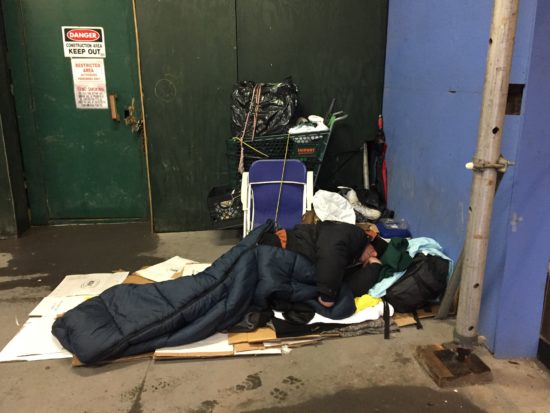
By Carol Tannenhauser
Considering the amount of discomfort and controversy their presence engenders, you would think there were hundreds of homeless people living on the streets of the Upper West Side. In fact, there are currently about 32, according to statistics sent to WSR by the NYC Department of Homeless Services (DHS). Some nonprofits claim that number is underestimated, but even if it were doubled, it should still be relatively easy to get that many people housed, you might also think. Why doesn’t the city get it done?
It isn’t for lack of trying. The city spent $3.2 billion on homelessness in 2019, up from $1.5 billion in 2014, according to the Wall Street Journal. “It has to do with the nature, circumstances, and experiences of each person on the street,” said Issac McGinn, a spokesperson for DHS, in a telephone interview.
No one has to live outside in New York City. By virtue of the Callahan Consent Decree of 1981, everyone who is homeless has a legal right to shelter. If you want a bed, the city must provide one (and more.) Indeed, over 60,000 homeless people are currently being housed and fed in city shelters, often run by nonprofits. The “individuals experiencing unsheltered homelessness,” as DHS prefers to call them, choose not to come inside and cannot be forced to, or to accept services. In many cases, mental illness and substance abuse play a role, but it also has to do with “holding onto their independence,” said Lisa Lombardi, deputy executive director of Urban Pathways, a nonprofit that has been helping homeless New Yorkers move into and sustain permanent housing for 45 years.
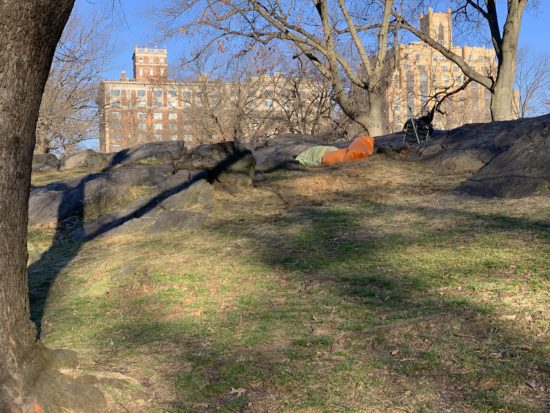
“These are people who have fallen through every available social safety net,” McGinn said, “and for one reason or another may be distrustful of institutional settings. They may have had a bad experience when they turned to government for help in the past. Our work is a slow, persistent process of rebuilding that trust.”
It begins with outreach. The local nonprofit Goddard Riverside is the social service agency contracted by the city to cover the UWS, from the river to Central Park West. Their outreach teams perform regular rounds — three times daily, seven days a week — among the neighborhood’s unsheltered population, building relationships and “all-important trust,” Lombardi said. They try to get individuals to accept services and ultimately “come inside.”
To make the process easier and less onerous, in the early 2000s, in partnership with nonprofit service provider Bowery Residents’ Committee, the city piloted a type of “low-barrier” facility for individuals coming off the streets, called a “Safe Haven.” From those original 19 beds, there are now more than 1,800 Safe Haven beds throughout the city. Last month, Mayor Bill de Blasio announced plans to bring 1,000 additional Safe Haven beds online in the next two years, according to McGinn. And 350 are already in development.
Safe Havens are alternatives to traditional homeless shelters. They are smaller and lack the rigid rules, such as curfews and required sobriety. (There are rules against using substances onsite.) There’s a Safe Haven operating quietly in a townhouse in the West 100s, not far from Central Park, run by Urban Pathways. (We are omitting the exact street to protect the privacy of the residents.) WSR visited the 33-bed facility last week.
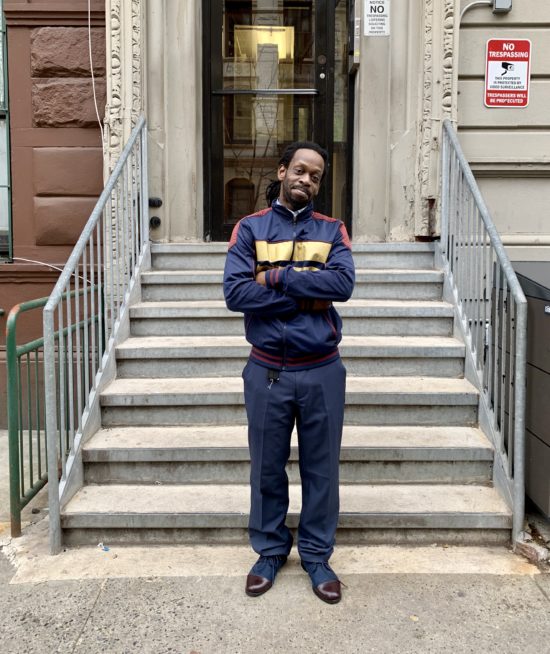
There we met Marc, who is about to move into his own place in Astoria, Queens, after having lived on the streets — first in Florida, then Texas, then New York City — for 17 years, from the time he was 18. He doesn’t drink or use drugs, “unless you count marijuana,” he said. He isn’t mentally ill and he doesn’t have a criminal record. He’s a 35-year-old man whose divorced mother died when he was 15, leaving him and four siblings in the care of an older sister who was hardly more than a child herself. When he was 17, she kicked Marc out. He was 31 before he finally got the help and guidance he needed to start to build a stable life. It began with Goddard Riverside’s outreach team.
“Goddard Riverside found me,” he recalled. “I was sleeping on 106th Street where there’s a fork in the road — that triangular park — and I heard somebody say, ‘Excuse me, sir. Do you need help?’ And I went, ‘Yes!’”
“Marc is unusual, because he’s very self aware.” said Lisa Lombardi, who oversees the Safe Haven. “It’s often much harder. Still, we place about 25 people a year in permanent, often, supportive housing.” Supportive housing generally means subsidized housing with onsite social services. Marc had two prior placements that “didn’t stick,” Lombardi said, before arriving at the UWS Safe Haven.
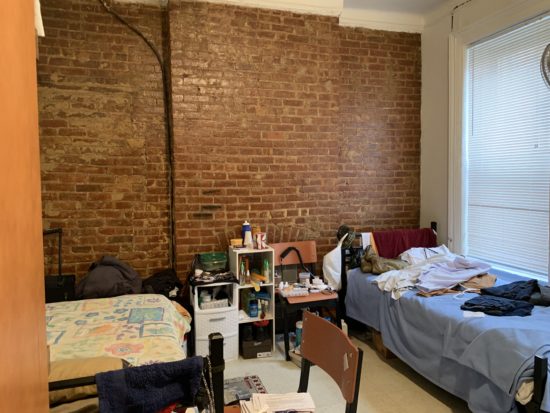
”There’s a lot of personalities in here,” he said, “but we make it work.” The facility offers single and double rooms, with singles serving as rewards for progress. There is an adjacent office with staff, including a director, case manager and housing specialist, and a kitchen, laundry room, and dining area. Three meals a day are offered, with a side of social services: case management, job readiness training, and help finding permanent housing.
“You see the physical transformation of clients, because they’ve been out there for so long, not in a bed, not taking care of themselves,” said Lisa Lombardi. ”They come in and begin to look better after one good night’s sleep. We help them make the connection between wellness and self management, and also, when you stop using drugs or drinking so much, you’ll feel better, and maybe eventually stop altogether.”
“The location is amazing,” Lombardi continued. “That’s what we want for our clients. Lets face it, it makes them feel good. And when you go outside, you wouldn’t know what we are…that’s what we want for the neighborhood. We want to be a good neighbor and partner. That’s what Urban Pathways is all about. We have a great landlord. If there are concerns we deal with them.”
According to Arianna Fishman, press secretary of DHS, more than 2,450 formerly unsheltered individuals experiencing homelessness have been placed in permanent housing throughout the city since 2016. There are currently approximately 3,500 left. Marc reflects about his own journey.
“When you’re on the street, your primitive brain kicks in,” he said. “It’s all about survival. You’re thinking about where you’re going to eat and sleep all day. What got me through really was the strength of my mom. It became tenfold in me. What she went through in the 80s and 90s empowered her little boy to be strong. I think she’d be really proud.”
Fishman asked the last question of Marc: “What do you wish you could have said to pedestrians passing you by when you were still on the street?”
He thought, cried a little, then said, “If you only knew that a rose could grow from the concrete.”
Coming next: When people who are experiencing unsheltered homelessness act badly.






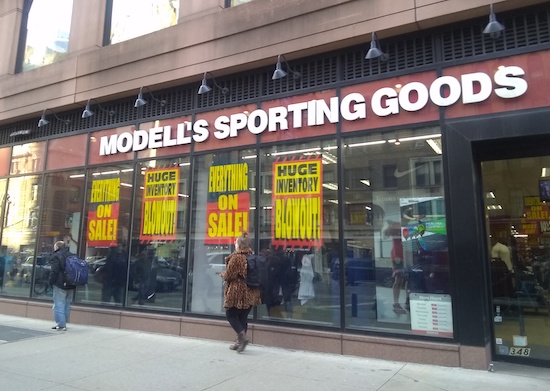
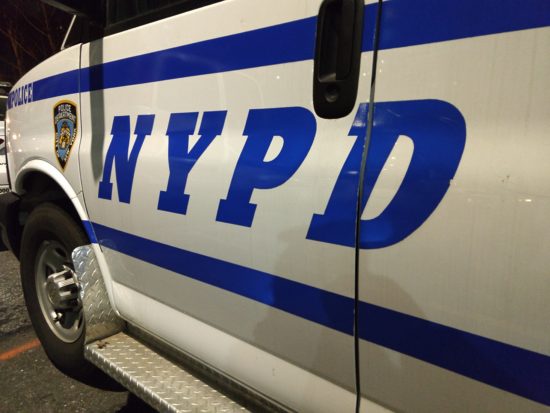
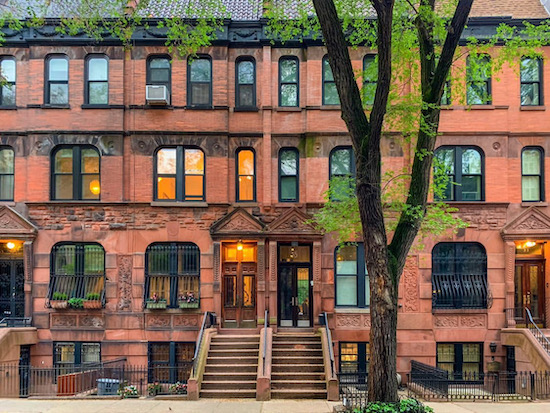
Does anybody know what happened to the homeless man that cleaned up all the trash cans in the 75th and broadway area? You could always see him either hard at work or constantly reading. He was an interesting guy – very into the eco side of being homeless – though obviously he must have had some issues. Anyways it seems like sometime before or around the holidays he disappeared.
I have been wondering the same thing.
I would suggest everyone watch the PBS Frontline, “Right To Fail”.
While the caring and compassion of the people that do this outreach is commendable and the story of “Marc” is encouraging, the reality for most is much different and the impact on the community is great.
Why on earth is an obviously mentally impaired person allowed to “live” in filth for years in front of Victoria’s Secret? Of course this is nothing new, why was Larry Hogue allowed to terrorize the UWS for years? Why are the “homeless” kids with their dogs whoa re scammers allowed to panhandle at will all over? Are they included in this count?
The reality is that the ramifications of Geraldo’s report on Willowbrook are still being felt and there has been no successful solution. In the meantime, the rest of us including children must deal with the stench, the screaming and the threats and sometimes the violent behavior of these sick people.
I am sorry your privilege blinds you to compassion for the homeless and homeless mentally ill. May you never find yourself unable to work, or unable to pay medical bills, or afflicted with mental health issues and unable to afford to treat them. And if you do ever become homeless, may those passing you on the street as you wallow in your stench show more compassion toward you than you have toward those in such circumstances.
Simmer down, Al Rose. For many of us it’s actually possible to have compassion for folks in need while fighting to maintain a decent quality of life and safety for ourselves and our loved ones.
32?
Seems low.
On 73rd & Broadway, at times, there are at least 8, hanging out under the scaffolding.
But – the numbers don’t matter.
The quest to find a humane solution matters.
Will be interesting to read this series, thanks for doing it.
32!? I’d’ve guessed triple that between 72 and 96 Streets. I guess our First Lady’s mental health outreach can be considered about as successful as her husband’s pledge to ban the carriage horses.
Thank you for bringing light and understanding to difficult conditions in the neighborhood. I’m looking forward to reading more about this situation.
32 is incorrect at best. Just on west 63 and Broadway around Starbucks in a one block radius I see 9 every morning when I leave my apartment at 4:50 am.
I think this proves that the issue is not one of funding or lack of caring. The issue is most of these people have substance abuse issues or mental or both. Leaving them on the streets is inhuman – regardless of what DeBlasio and others claim is with in their right. Being homeless is not illegal, agreed; not helping people who need professional help is in-humane.
excellent article. Very informative. This helps combat the dehumanization of the homeless. Marc has a name, a story… he’s our neighbor.
I’m also glad you gave some description to the activities of agencies like Goddard Riverside and Urban Pathways. These agencies are just as much part of the neighborhood as NYPD, and it’s good to know what they do. The people who work there do extremely important work.
What is the story with the two women who have lived outside Arties Deli for years? They have set up home, knit, have cell phones and iPads. They do not disturb anyone, ask for money, and eat good food. They do not seem mentally disturbed or addicted. Reading this article it seems they could live in a two person apt.
I have wondered about them as well if I am thinking of the same people. They look like sisters.
I wonder if someone tried to help them or talk to them?
People have tried to help them. If I’m not mistaken they were taken off the street at least twice and chose to go back. The younger one always waved when I walked by but if I tried to approach them she hid under a blanket or coat. I’ve asked the older one if she needed help but she just looked right through me. They were ‘living’ on the opposite side of the street in the summer. So sorry to hear that they’re still outside.
On my block alone there are 6-8 daily. We know them. I wrote to Jacqueline du prey at the Mayor’s office asking what happened to the $850 million his wife was given to help with the mentally ill in NYC and she could only report to me that homelessness is down. Really? I asked her how I should feel safe letting my child get on and off the bus to go to school while watching someone defecating on the street or whipping out their private parts. She responded by saying I could help by calling 311. Ha! No one would come and help. It’s a joke!
NYC Department of Homeless Services numbers must be for a very small test search area. The UWS goes at least to 110 street from 59, river to park. Yes there is any UWS above 86th street as those of us that live here as well as the city and the real esate folks. I can count this many just walking across 57, 59, 66, 72, 79, 86, 96, 106, or 110th. Let alone walking on Broadway. The city has years played down the numbers.
As for the $$$, there are aprox 70,00 homeless, officially, any give moment. Well 3.2 billion gives them each $45,714.29 tax free.
I first saw those two women “camping” on 79th street between Broadway and West End. I was surprised as they were well dressed, orderly. I figured they’d just arrived in the city and couldn’t find a place to live. Then they were on 75th street outside the designer discount store. One was knitting something lovely in white yarn. Next thing I knew they were in front of Arties. At one point one of the women looked about six months pregnant. I found that pretty unnerving. While in front of the designer store one morning, two people hired by the store were putting up signs outside the window and asked the women, nicely to move away so they could do their work. The one who was knitting started shrieking at them, long after they’d left. I was shocked as they’d always seemed so docile. Life on the street hardens one. I often wonder about their lives before the streets, where they’re from. Does anyone know anything more about them?
I don’t know what time they did the census but many of these people don’t settle in to their sleeping locations until 10 or 11 pm. I bet the #s would be a lot higher at dawn.
There’s a couple guys who have set up camp near Papaya dog on W 72. Walking under the scaffolding feels like walking through their bedroom. Beds, pillows, places to sit so they can play video games and trash strewn about. Place is disgusting. You’d think they’d keep it clean. Not like they don’t have the free time. They like to panhandle at 72 and Columbus. I refuse to give them a penny when their encampment looks like a disgusting blight to our neighborhood. Wish they had just an ounce of pride.
The homeless men at papaya are aggressive, they chased my husband with my baby in a stroller, shouted obscenities and rats run over the garbage. We’ve called the police and 311 daily for 4 months. Maureen Donohue-Peters of Donohue Steakhouse owns the building and has no contact information. The businesses are suffering and the police apparently can’t move them even though they are loitering, throwing garbage, harrassing people, and blocking a building’s doorway. The scaffolding company told us they have 0 responsibility. We’ve starting looking at moving after we wrote letters to the community board and they sent us canned answers about homeless shelters and other BS. We’ve been here for 10 years, it’s really sad. Young families don’t feel safe, the UWS mom blogs go crazy with daily incidents of nannies and children harassed and even attacked. It saddens me that it’s easier to mobilize to argue over the height of the building than the safety of the people that live here.
If you are ever thinking, “how can I help?” Send a donation to Goddard Riverside. They are there doing the outreach and meeting the homeless where they sleep!
There are sisters who look like twins, usually wearing all black, jeans with heels. They each carry a large bag. They don’t ‘seem’ homeless. I have actually seen them at varied hours just walking the streets together. I believe they are Israeli. Anyone know who I mean? They look about 60’s? Well put together. Made up nicely.
This is infuriating to say the least. 32 homeless is completely incorrect. The UWS has become a bedroom for drunk, obscene, mentally ill people who harass pedestrians and scare kids. Everyday we are accosted by them one way or another. I have gone into many stores to discuss them blocking doorways and the answer is always “Mayor DeBlasio won’t let the police do anything”. Is this true? A man is lying in filth half naked and DeBlasio doesn’t “allow” police to do anything? Does anyone know this “law” that allows 6 drunk loud men to camp out in front of North Face or Rite Aide and harass people? I’d like to see the wording on this. DeBlasio must be the worst mayor we’ve ever had. Sadly, the UWS is ground zero. UES looks so much better-cleaner and less like a third world country. The broken Windows theory lives on here. Check out the corners on Broadway 73rd/74th etc. Where broken dirty newspaper boxes are lined up. The plastic is broken and jagged on AM NY
box and rats are pLaYing…is that paper even still around? It seems hopeless for 10023. We’re angry….we want them off our streets, we want a clean decent neighborhood where walking one block doesn’t frighten, nauseate, and sadden everyone.
I agree with you. I work on the UES and I take the 86th st crosstown bus home every day and then walk from 86th and B’way to the 70’s and it’s truly mind numbing. There are homeless people on east 86th & Lexington, but not in the numbers that we have throughout our entire neighborhood.
In December when the Christmas tree vendor was on B’way I accidentally bumped into a homeless woman and she threw herself down on the sidewalk and started screaming (not AT me, but just screaming). A few blocks down another woman asked me for quarters and then she followed me all the way to DR on 72nd barking at me. That’s when I started counting, and I passed 4 homeless women and 30+ men, but that was before they started sleeping in groups under the scaffolding on 72nd and 74th.
I don’t understand why it’s become the norm here, but I’m getting fed up with everyone telling me how lucky I am to be living so close to Lincoln Center. Surely there must be something we’re missing…this isn’t happening on 5th, Madison, and Park Avenue. 🙁
Lynn: of course we are in agreement. What is the solution? I’ve contacted 311 and the 20th precinct and Linda Rosenthal and Helen Rosenthal and and and…..It just keeps getting worse. Move these people to the Gracie Mansion block and let’s see what happens. I always say, I’ve visited quite a few Third World countries; their city streets look better than NYC Upper Westside. I want to move out of this area. I’ve really had enough. Best to you and be careful.
Thank you Cj, and all the best to you!
Thanks for this story – a very helpful antidote to all the horror stories typically shared (or circulated) about the homeless. In a city as big, fast-paced and unwieldy as NYC, and a time as tense as the one we live in, we often forget how hard it can be to solve problems, and how randomly difficult some peoples’ lives can be. Thanks for an empathy-encouraging (for the homeless AND for the city and its bureaucrats) and appreciation-encouraging (for folks like Goddard-Riverside et al.) story.
“If you only knew that a rose could grow from the concrete!” Wow…what a powerful comment!
How many homeless?
Considering that many of those writing comments here seem to be referring to the same sets of homeless people, the number 32 may not be outrageously low. If the number troubles your sense of number then double it and relax. It remains a small number in a large neighborhood.
Why can’t we get them off the street?
They do not want to go and they can not be taken away and locked up.
Why do they not want to go to shelter, after all 60,000 folks are sheltered?
They are by and large insane and they can not be made sane. Their insanity is intractable and/or their insanity compels them to resist intervention. Their insanity might make living in a shelter unbearable. They are helpless and so are we. Life can be very cruel.
Why us and not the upper east?
Many homeless people are insane but that does not mean they are stupid. Experience has taught them that upper westsiders are, arguably, more likely to try to help than our crosstown neighbors. The homeless are playing the odds.
Is their plight a blight on our neighborhood.
Yes.
Can the mayor, any mayor, do anything to change the situation?
You tell me what they can do.
As big an issue is the mismanagement and lack of services for the thousands of people that the city and non-profits have placed in shelters and supportive housing on the Upper West Side. Many are mentally ill and/or substance abusers. They may have roofs over their heads at night, but they wreak havoc on the streets during the day with their aggressive panhandling and menacing behavior, not to mention littering etc. This issue needs to be addressed as much as providing a bed for someone for to sleep in.
re: what Rob G said: this does not jive with my experience at all. I know Rob G. lives in the same area i live in, circa Bway and 96th. i regularly walk the area between 92 and 102 on Bway, at all hours, including late at night. Do i see panhandlers? Sure. usually they average about 1 a block on the blocks around 96th.
“Aggressive” panhandling, “menacing behavior”? Simply untrue. I see someone who is aggressive, in any valid sense of the word, once every 6 months or less. Also absolutely no menacing. I have no idea who litters.
Rob has complained before about an elderly man who lives in Harlem United veteran’s housing on W. 95th. He regularly panhandles on Bway between 96th and 97th. This man is polite to a fault and certainly not aggressive in any way. Yet still there are complaints. How about you say hello, and maybe give him a dollar? he’s a nice guy who likes a friendly chat. Don’t be afraid of him!
Rob G. says:
“As big an issue is the mismanagement and lack of services for the thousands of people that the city and non-profits have placed in shelters and supportive housing on the Upper West Side.”
Why doesn’t Rob G. say WHICH agency he is talking about? I sit on the Advisory Board of Harlem United/Bailey House veterans supportive housing. I can assure you it is superbly managed and provides many services to the vets.
It also seems like the Urban Pathways Safe Haven described in the article is well managed and offers excellent supportive services.
It is highly unfair, and biased, to tar supportive housing and social service agencies on the UWS with a broad brush, and to do so anonymously. If you have a complaint about an agency, please have the decency to be specific. I have no idea if they are all good. I know the one i am involved with is very good. I suspect most others are as well, though maybe there are some bad apples.
Maybe it is different around 72nd street, i have no idea. But i know it is totally false to say that around 96th street “panhandlers have taken over the neighborhood.”
Marc, very very best of luck as you embark on the rest of your life! Astoria is awesome, hope you enjoy it.
The number is surely higher than 32. WNYC reported that a “senior official at the Department of Social Services urged non-profit partners to find more beds for the homeless ahead of the count last month so that the total number would be lower.” It was only AFTER the WNYC report that the mayor admitted to the practice.
Is this a joke? I just passed a half a dozen homeless people on my walk home from work, 9th Ave from 49th to 66th.
The Homeless..panhandlers and drug addicted have now taken over the four corners of 72nd St.It is impossible to walk your dog,enter Trader Joe”s or use the Capital One Bank or stop for the light in front of Greys”s without confronting them.Yesterday one of them entered Bloomingdale”s yelling and would not leave.When will this stop?
There is way more than 32 in our neighborhood.
Does anyone know what happened to the old man that used to stay infront of the La Unica Caridad Restuarant at the corner 78th and Broadway? He had a dog also. Last saw the guy around like 2014ish maybe? I remember i used to buy him a coffee and bread from the Europan that was there.